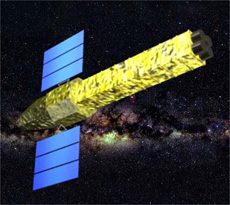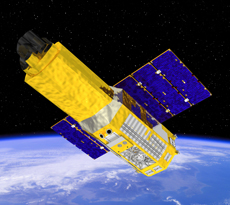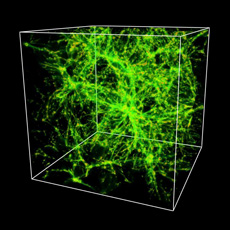


Next generation X-ray astronomy satellite NeXT
Q. How do these observations affect future research?
The achievements of the previous X-ray astronomy satellite ASCA are reflected in the design of Suzaku. Likewise, we will pass on the achievements of Suzaku to the next observation mission. Professor Yasuro Tanaka, who is the project manager of the satellite ASCA and was a leader in X-ray astronomy, said that ASCA’s observations revealed a lot of new facts, but generated even more questions. This happens often in science.
For example, we have known that X-ray emissions in the central region of our galaxy originate from high-temperature plasma; however, that just leads to new questions, such as where that plasma comes from and why it exists in the galactic central region. We don’t know what data we will obtain if we observe the huge black hole now being studied by Suzaku with much higher resolution than before. And although Suzaku is currently observing black holes that are relatively close to us, what will we find if we observe black holes more faraway, namely in the early universe?
In addition, we have known for some time that cosmic X-rays are accelerated by supernova remnants; however, some cosmic X-rays have energy levels so high that they cannot possibly come from a supernova remnant. Such ultrahigh-energy cosmic X-rays may have been created when galaxy clusters evolved. According to this theory, when the galaxy clusters, which were small at first, were colliding and merging into large ones, shock waves were created, which greatly accelerated the particles. The next X-ray astronomy satellite, NeXT, may confirm or refute this theory. We continue to try to answer all these questions.
Q.How is Suzaku perceived internationally?
One way to measure scientific achievement is the number of papers published relating to the research. If other scientists cite the published paper and take the discussion further, that becomes an objective indication that the research has impact in the field. Papers relating to Suzaku started coming out only about a year ago, but these papers have been cited frequently both at home and abroad, so we think that they are highly valued. Also, whenever we have held international conferences, we’ve discovered that there is a lot of interest in the research. We have held two international conferences focusing on Suzaku’s results, the first one in Kyoto in December 2006, and the second in San Diego, in the United States, in December 2007. Both times, nearly 300 participants attended, and about half of them were researchers from abroad. So we can say that researchers from all over the world have shown a lot of interest. Finally, the fact that many scientists from abroad are applying for guest observer program of Suzaku may be a proof that the satellite has gained worldwide recognition.
One way to measure scientific achievement is the number of papers published relating to the research. If other scientists cite the published paper and take the discussion further, that becomes an objective indication that the research has impact in the field. Papers relating to Suzaku started coming out only about a year ago, but these papers have been cited frequently both at home and abroad, so we think that they are highly valued. Also, whenever we have held international conferences, we’ve discovered that there is a lot of interest in the research. We have held two international conferences focusing on Suzaku’s results, the first one in Kyoto in December 2006, and the second in San Diego, in the United States, in December 2007. Both times, nearly 300 participants attended, and about half of them were researchers from abroad. So we can say that researchers from all over the world have shown a lot of interest. Finally, the fact that many scientists from abroad are applying for guest observer program of Suzaku may be a proof that the satellite has gained worldwide recognition.

X-ray Astronomy Satellite Suzaku
Q.How is Suzaku doing right now?
Suzaku was launched in July 2005. Test observations were completed by March 2006, and since then we have performed the first cycle of the guest observer program in which observation targets are selected by peer review from proposals from scientists around the world. Currently, about 95 percent of Suzaku’s observation time is used for the guest observer program. The remaining time is reserved for unexpected celestial events, for example if a supernova appears suddenly. We observe one celestial body typically for one to two days, so we observe 150 to 200 celestial bodies in a year. Suzaku is an international project, and we seek as many ideas as possible from scientists around the world, so we employ the guest observer program. For this program, JAXA, NASA and the European Space Agency (ESA) are the contact points. We get four times more proposals that we can accommodate, so we think the competition is very high. This spring, we have started the cycle three guest observer program. The proposer of a successful proposal has exclusive data right for one year; after that, the data are made public. A lot of data are already publicly available.


The X-ray map of the central region r of the Milky Way by the X-ray astronomy satellite Chandra. (Courtesy of NASA, UMass, D. Wang et al.)
Q.What are your future priorities for Suzaku?
There two long observations selected from Japanese proposals. The first one is to observe the central region of the Milky Way. In the present Suzaku X-ray map of the central region of the Milky Way, there are unobserved portions. We want to fill in such blank portions, and observe a wider segment of the central region of the Milky Way. In addition, because X-rays reveal to us only a very small part of cosmic phenomena, we think it is very important to make observations in tandem with another satellite, which focuses on another wavelength. In that sense, the second proposal makes observations together with the Gamma Ray Large Area Space Telescope (GLAST) of the United States, which will be launched in this year. This will allow us to deepen our research into active galactic cores and cosmic rays.

The spatial distribution of dark baryons predicted by a computer simulation of the evolution of the universe. The length of one side of the cube is 470 million light-years. (Cen & Ostriker 1999, ApJ 514, p1)
Q.What do you particularly want to study with Suzaku?
Observations conducted by the Wilkinson Microwave Anisotropy Probe (WMAP) show that 96 percent of the universe is made up of invisible substances, of which 23 percent is dark matter and 73 percent is dark energy. Since we cannot directly detect these substances by means of electromagnetic waves, such as visible light, infrared rays or X-rays, we have no idea at all what they are. The remaining 4 percent is observable substance, such as stars and galaxies. It is called “baryonic matter,” or simply, “baryon.” However, even if we add up all the stars, galaxies and the high-temperature gases in galaxy clusters, the sum of all that is less than half of the baryon that should exist in the universe. From the amount of helium existing in the universe and the observations from the WMAP, we know that 4 percent of the total universe is baryon, but we do not know where the remaining baryon exists. We call this “dark baryons.”
Recent research indicates the possibility that the greater portion of baryon consists of extremely dilute gases at temperatures from one hundred to ten million degrees, distributed in a filamentary shape along the large-scale structure of the universe. This is an intergalactic matter with a web-like structure that connects the galaxy clusters. Although at such temperatures it emits ultraviolet rays or soft X-rays, so far, the dark baryons are too dilute thus too dark to observe. Suzaku is observing the outer regions of galaxy cluster based on a hypothesis that the dark baryon may be relatively dense and thus it may be possible to find signature of it.
If we can determine the distribution of the dark baryons in the universe, we should be able to see more precisely how dark matter is distributed in the present universe. And that, we hope, will allow us to constrain various past events in the evolution of the universe, which may lead to understanding of dark energy. Anyway, the fact that we cannot see what should be there is rather disturbing. It will take a long time for us to understand the dark baryons, and we’ll need far more powerful observation instruments. But Suzaku will allow us to take the first step.

Q.What makes astronomy so attractive?
Most of the questions of the universe contains fundamental questions, and they are endlessly questioning to us. The more we study the universe, the more incomprehensible it seems, and the more new questions arise.
It’s very exciting to develop instruments that observe the universe. We do almost everything, from building the spacecrafts to operating it to make observations. Both are great things to develop instruments and to obtain scientific results. And by offering the observation time to other scientists, we are helping people around the world achieve good results as well.
The universe is still shrouded in mystery, and with each new fundamental discovery, a new question arises. When I was a student, the existence of black holes and neutron stars were mere hypotheses. Today, students start by taking their existence for granted. In the initial stage of this research, we were asking basic questions such as, „Is this a black hole or a neutron star?„ Now we know. Now we ask questions such as, „Why do a black hole and a neutron star emit radiations? And „How are black holes and neutron stars were created, and how do they evolve?„ Astronomy is very attractive because it provides endless questions, most of which are of fundamental importance. I hope these issues will continue to fascinate me.
Dr. Kazuhisa Mitsuda
Doctor of Science, Professor, Department of High Energy Astrophysics, Institute of Space and Astronautical Science, JAXA
Dr. Mitsuda graduated in 1984 from the Department of Physics of the Graduate School of Science at the University of Tokyo. He was a research associate and assistant professor at ISAS. He has been a professor at ISAS since 2000. In 2005, Dr. Mitsuda was appointed to the position of project manager for the X-ray astronomy satellite Suzaku. His major fields are X-ray astronomy and astrophysics.
Doctor of Science, Professor, Department of High Energy Astrophysics, Institute of Space and Astronautical Science, JAXA
Dr. Mitsuda graduated in 1984 from the Department of Physics of the Graduate School of Science at the University of Tokyo. He was a research associate and assistant professor at ISAS. He has been a professor at ISAS since 2000. In 2005, Dr. Mitsuda was appointed to the position of project manager for the X-ray astronomy satellite Suzaku. His major fields are X-ray astronomy and astrophysics.
X-ray Astronomy Satellite
Suzaku
Infrared Imaging Satellite
AKARI
Solar Physics Satellite
HINODE
Radio-Astoronomical Satellite
ASTRO-G